#HandwritingExercises
Explore tagged Tumblr posts
Text
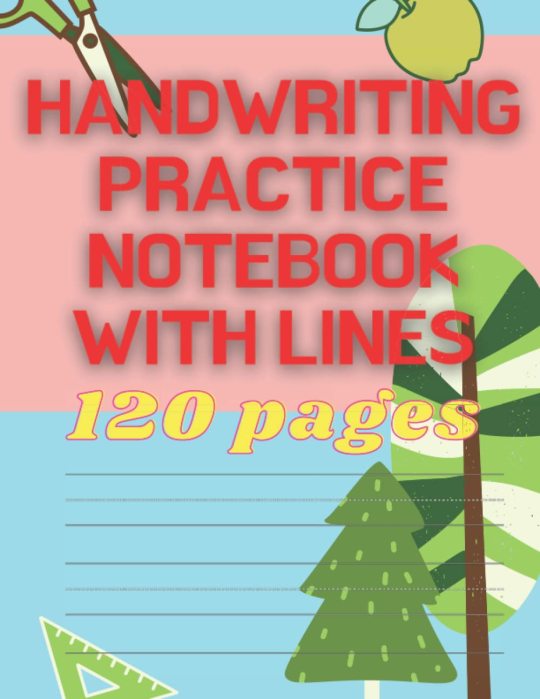
HANDWRITING PRACTICE WORKBOOK WITH LINES FOR KIDS: 120 BLANK PAPERS OF DOTTED LINES FOR ABCDs AND WRITING PRACTICES Paperback – Jan. 21 2022
by TEACHUS Pressing (Author)
GRAB LIST OF AMAZON SELLERS
This workbook includes:
Cute cover, 8.5 x 11 inches workbook
120 Pages
Dotted and Practice Lines for Kids and Students
This high quality work pad is for kids and everybody really, to hone their writing skills in ABCs and even their cursive handwriting. A right choice for your kids and to give to relatives and students in general. Any reviews below is appreciated to help us better our work in the future. Thank you for your patronage!
#handwriting#workbook#handwritingpractice#handwritingimprovement#handwritingtips#handwritinggoals#handwritingchallenge#handwritingclass#handwritingworkshop#handwritingexercises#handwritinglessons#handwritingskills#handwritingforbeginners#handwritingforkids#handwritingforadults#handwritingtherapy#handwritinganalysis#handwritinginspiration#handwritinglove#handwritingcommunity#handwritingisfun#handwritingmatters#handwritingteacher#handwritingtutor#handwritingresources#handwritinghelp#handwritingeducation#handwritingdevelopment#handwritingjourney
0 notes
Text
Calligraphy Practice Exercises: Hone Your Skills
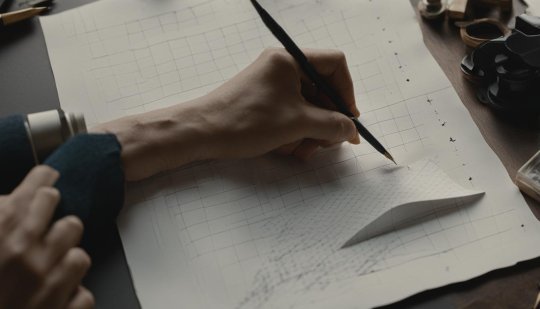
Calligraphy Practice Exercises: Essential Drills for Improving Your Lettering
Calligraphy is a beautiful art form that requires practice and patience to master. In this section, we will explore various calligraphy practice exercises that can help you improve your pen control, perfect your flourishes, and elevate your overall calligraphy skills. These exercises have been recommended by professional calligraphy artists and have proven to be effective in honing your calligraphy skills. Key Takeaways: - Regular practice is essential for improving your calligraphy skills. - Calligraphy practice sheets and worksheets provide structured exercises for honing your skills. - Start with basic exercises and gradually progress to more advanced drills to challenge yourself. - Choose the right practice sheets that suit your needs in terms of size, slant, and paper type. - Utilize free calligraphy practice sheets and worksheets available online to enhance your skills.
The Importance of Practice in Calligraphy
Practice is essential for improving any skill, and calligraphy is no exception. By regularly practicing calligraphy exercises, such as pen control drills and flourishes, you can develop muscle memory, improve your hand-lettering technique, and enhance your overall calligraphy skills. These practice exercises are designed to help you gain control over your pen strokes, refine your letterforms, and cultivate a unique calligraphy style. Through consistent practice, you can improve your calligraphy skills and create stunning hand-lettered pieces. When you practice calligraphy, you give yourself the opportunity to experiment with different techniques and styles. It allows you to explore various letterforms, strokes, and flourishes to find what resonates with you. By dedicating time to practice, you can refine your skills and develop your own unique artistic voice. Remember that calligraphy is a journey, and improvement takes time. Embrace the process and be patient with yourself. Set aside regular practice sessions, even if it's just a few minutes each day. Consistency is key in building muscle memory and improving your pen control. "The expert in anything was once a beginner." - Helen Hayes The Benefits of Regular Calligraphy Practice Regular calligraphy practice offers several benefits that contribute to the improvement of your skills. Firstly, it helps to develop muscle memory, allowing your hand to move fluidly and effortlessly as you create strokes and letterforms. With practice, your hand becomes more familiar with the movements required for calligraphy, resulting in smoother and more consistent penmanship. Secondly, regular practice allows you to experiment and explore your creativity. As you try new techniques and styles, you expand your repertoire and develop your own unique calligraphy style. Practice sessions provide an opportunity for self-expression and growth as an artist. Lastly, practice helps to build confidence. The more you practice, the more comfortable you become with the tools and techniques of calligraphy. This confidence shines through in your work, allowing you to create beautiful and impactful pieces. How to Incorporate Practice into Your Routine To make the most of your calligraphy practice, it's important to establish a routine that works for you. Consider setting aside dedicated time each day or week for practice. Treat it as a non-negotiable appointment with yourself, just like any other commitment. Create a comfortable and inspiring workspace where you can fully immerse yourself in your practice. Surround yourself with tools, materials, and inspiration that motivate and excite you. Whether it's a designated corner of your home or a portable practice kit, make sure it's a space that sparks your creativity. Additionally, consider joining a calligraphy community or finding a practice partner. Connecting with others who share your passion for calligraphy can provide valuable feedback, inspiration, and accountability. Whether online or in-person, these communities offer a supportive environment for growth and learning.
Calligraphy Practice Sheets and Worksheets
Calligraphy practice sheets and worksheets are valuable resources for honing your calligraphy skills. These structured exercises provide guided lines, stroke sequences, and lettering drills that allow you to practice specific techniques and styles. Whether you're a beginner or an experienced calligrapher, using calligraphy practice sheets can help you refine your strokes, improve your letterforms, and enhance your overall calligraphy skills. There are various types of calligraphy practice sheets available to suit different preferences and areas of focus. Traditional calligraphy practice sheets are designed to help you master classic scripts like Copperplate or Spencerian. Modern calligraphy practice sheets cater to those interested in contemporary lettering styles. Brush lettering practice sheets focus on developing skills specific to using brush pens, while digital calligraphy practice sheets offer exercises for creating calligraphy on digital platforms like the Procreate App. By incorporating calligraphy practice sheets into your routine, you can establish a structured approach to learning and refining your calligraphy technique. These sheets provide a solid foundation for building muscle memory, improving pen control, and exploring various lettering styles. With consistent practice using these resources, you'll be on your way to creating beautiful, professional-quality calligraphy in no time.
Basic Calligraphy Exercises for Beginners
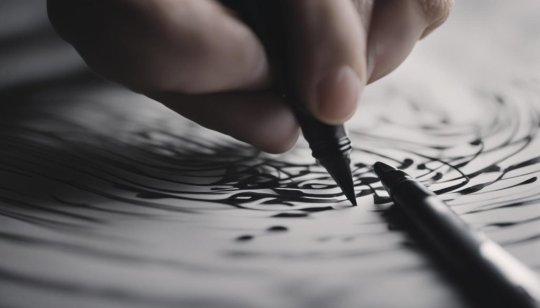
If you're new to calligraphy, starting with basic calligraphy exercises is a great way to build a strong foundation. These exercises focus on fundamental strokes, such as upstrokes and downstrokes, transitioning between thick and thin strokes, and creating oval shapes. By practicing these drills, you can improve your pen control, learn proper letter formation, and develop a consistent writing style. These exercises are designed to help beginners develop the necessary skills and techniques for creating beautiful calligraphy. One of the key calligraphy drills for beginners is practicing upstrokes and downstrokes. This exercise involves applying pressure to create thick downstrokes and releasing pressure for thin upstrokes. By mastering this technique, you can achieve the desired contrast in your letterforms. Another important drill for beginners is transitioning between thick and thin strokes. This exercise helps you understand how to vary the pressure on your writing instrument to create different line weights. It's essential for creating elegant and dynamic letterforms in calligraphy. Basic Calligraphy Exercises for Beginners Description Upstrokes and Downstrokes Practice applying pressure to create thick downstrokes and releasing pressure for thin upstrokes. Transitioning Between Thick and Thin Strokes Learn how to vary the pressure on your writing instrument to create different line weights. Creating Oval Shapes Master the technique of smoothly transitioning from thin to thick strokes to create oval shapes. In addition to these drills, beginners can also practice creating oval shapes. This exercise involves smoothly transitioning from thin to thick strokes to form perfectly rounded shapes. Mastering this technique will help you create beautiful flourishes and decorative elements in your calligraphy. Remember, practice is essential for improving your calligraphy skills. By dedicating regular time to these basic calligraphy exercises, you can develop the necessary foundation to progress to more advanced techniques and styles. So grab your pen, find some practice sheets, and start honing your calligraphy skills today! Resources: - Calligraphy for a Latté: Basic Calligraphy Drills - Cursive Calligraphy for Beginners: An Easy Way to Start
Advanced Calligraphy Exercises for Skill Development
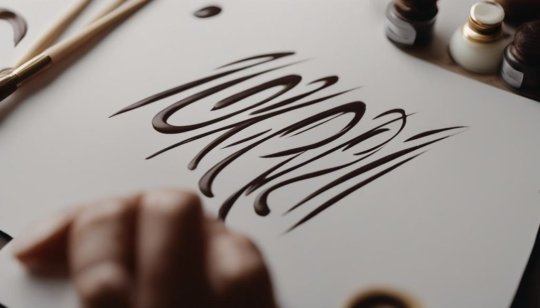
If you're looking to take your calligraphy skills to the next level, it's time to challenge yourself with advanced calligraphy exercises. These exercises are designed to push your skills beyond the basics and allow you to explore more complex techniques and styles. By regularly practicing these advanced exercises, you can further develop your own unique lettering and refine your overall calligraphy technique. One of the key areas to focus on in advanced calligraphy is brush lettering. Brush lettering involves using a brush pen or a paintbrush to create thick and thin strokes, adding depth and dimension to your letterforms. By practicing brush lettering drills, you can improve your control over the brush, experiment with different pressure variations, and create beautiful calligraphic compositions. Another important aspect of advanced calligraphy is mastering various calligraphy drills. These drills focus on specific aspects of calligraphy, such as achieving consistent spacing between letters, creating intricate flourishes, and perfecting complex stroke combinations. By dedicating time to practicing these drills, you can enhance your overall technique, develop your muscle memory, and expand your repertoire of lettering styles. Finally, using practice sheets specifically designed for advanced calligraphy can be immensely helpful. These practice sheets provide guided lines and exercises that challenge you to experiment with different shapes, angles, and lettering styles. They can also serve as a valuable reference as you work on perfecting your technique and developing your own unique calligraphy style. Benefits of Advanced Calligraphy Exercises Examples Enhances brush lettering skills Creating thick and thin strokes, experimenting with pressure variations Refines overall calligraphy technique Mastering spacing, creating intricate flourishes, perfecting stroke combinations Expands repertoire of lettering styles Practicing different shapes, angles, and calligraphy styles "Advanced calligraphy exercises allow you to push the boundaries of your skills and explore new possibilities in lettering. By challenging yourself with more complex techniques and drills, you can greatly enhance your calligraphy skills and create stunning hand-lettered pieces." - Professional Calligraphy Artist Take Your Calligraphy Skills to New Heights If you're ready to take your calligraphy skills to new heights, start incorporating advanced calligraphy exercises into your practice routine. Dedicate regular time to brush lettering, explore different calligraphy drills, and utilize practice sheets specifically designed for advanced techniques. Through consistent practice and experimentation, you can continue to grow and improve as a calligrapher, developing your own unique style and creating breathtaking hand-lettered artworks.
Choosing the Right Calligraphy Practice Sheets

When it comes to improving your calligraphy skills, choosing the right calligraphy practice sheets is crucial. These sheets provide structured exercises that allow you to practice specific techniques and styles, helping you refine your strokes, improve your letterforms, and elevate your overall calligraphy skills. Here are a few factors to consider when selecting the perfect practice sheets: - Size: The size of the practice sheets should be compatible with your writing utensil, whether it's a brush pen, dip pen, or a regular pen. Opt for sheets that offer enough space for you to comfortably practice your strokes and letterforms. - Slant: Consider the calligraphy script you are practicing, such as Copperplate or Spencerian, and choose practice sheets with the appropriate slant. This will help you maintain consistency and accuracy in your letterforms. - Paper Type: Different writing utensils require different types of paper. For brush pens, marker paper is recommended to prevent ink bleeding. On the other hand, dip pens work best with premium 32lb paper, which can handle the ink flow without feathering or smudging. By selecting practice sheets that suit your specific needs, you can ensure a more effective and enjoyable calligraphy practice experience. Sample Calligraphy Practice Sheets Here is a sample of calligraphy practice sheets that you can use to enhance your skills: Sheet Type Focus Recommended for Basic Strokes Mastering fundamental strokes Beginners Alphabet Lettering Improving letterforms and consistency All skill levels Flourishes Practicing intricate embellishments Intermediate to advanced These practice sheets are just a starting point, and there are countless resources available online that offer a wide range of practice materials. Explore different styles, techniques, and scripts to continuously challenge yourself and improve your calligraphy skills.
Free Calligraphy Practice Sheets and Worksheets

Enhance your calligraphy skills with a wide range of free calligraphy practice sheets and worksheets available online. These resources provide valuable practice materials for both beginners and experienced calligraphers, allowing you to improve your hand lettering and lettering techniques. Whether you're interested in traditional calligraphy or modern calligraphy, you can find a variety of free practice sheets that suit your needs and skill level. These practice sheets cover everything from basic strokes and alphabet lettering to more advanced techniques and styles. By regularly using these practice sheets, you can refine your calligraphy strokes, perfect your letterforms, and develop your own unique calligraphy style. Many professional calligraphers and calligraphy enthusiasts generously share their worksheets for free, making it easier for aspiring artists to access high-quality practice materials. So, take advantage of these free resources and start practicing your calligraphy skills today. With consistent practice and dedication, you'll be amazed at how quickly you can improve and create stunning hand-lettered pieces. "Practice makes perfect. Take advantage of the free calligraphy practice sheets and worksheets available online to sharpen your calligraphy skills. These resources provide structured exercises that target specific techniques and styles, allowing you to refine your strokes, improve your letterforms, and enhance your overall calligraphy skills." - Calligraphy Master Benefits of Using Free Calligraphy Practice Sheets Using free calligraphy practice sheets offers several benefits for calligraphy enthusiasts: - Structured Exercises: Practice sheets provide guided lines, stroke sequences, and lettering drills that help you practice specific techniques and styles in a structured manner. - Progress Tracking: By using practice sheets regularly, you can track your progress and see how your skills improve over time. - Diverse Styles: Free practice sheets cover various calligraphy styles, giving you the opportunity to explore different lettering techniques and find your own unique style. - Accessible Resources: With numerous calligraphy practice sheets available online for free, you can easily find and download practice materials that suit your preferences and skill level. Practice Benefits Using structured exercises Improves pen control and letter formation Tracking progress Allows you to see improvement over time Exploring diverse styles Helps you find your unique calligraphy style Accessing free resources Provides easy and cost-effective practice materials
Practicing Calligraphy for Improvement
https://www.youtube.com/watch?v=WnCZKh8E68Q Consistency is key when it comes to improving your calligraphy skills. By dedicating regular time to practice and focusing on targeted exercises, you can enhance your technique and achieve the desired results. Here are some tips to help you get the most out of your calligraphy practice: - Start with basic calligraphy drills: Begin your practice sessions with exercises that focus on fundamental strokes and letterforms. This will help build a strong foundation and improve your pen control. - Gradually progress to more advanced drills: Once you feel comfortable with the basics, challenge yourself with more complex exercises. This could include practicing intricate flourishes, experimenting with different line thicknesses, or working on control with different shapes and angles. - Set specific goals for each practice session: It's important to have a clear objective in mind when practicing. Whether it's mastering a specific letterform or improving your spacing, setting goals will help you stay focused and measure your progress. - Record and compare your progress: Keep a record of your work and regularly compare it to older pieces. This will allow you to see how far you've come and identify areas where you can continue to improve. - Learn from mistakes: Mistakes are a natural part of the learning process. Embrace them as opportunities for growth and use them to refine your technique. Remember, practice is the key to improving your calligraphy skills. Stay dedicated, be patient with yourself, and enjoy the journey of honing your craft. Table: Common Calligraphy Drills Drill Description Upstrokes and Downstrokes Practice creating smooth and consistent upstrokes and downstrokes, focusing on maintaining a consistent angle and pressure. Transitioning between Thick and Thin Strokes Master the art of creating thick and thin strokes by gradually increasing and decreasing the pressure on your pen. Oval Shapes Create perfect oval shapes by practicing your hand movement and maintaining a consistent width throughout the stroke. Flourishes Experiment with different types of flourishes, such as loops, curls, and spirals, to add flair and elegance to your lettering. Regularly incorporating these drills into your practice routine will help you develop muscle memory, improve your technique, and elevate your overall calligraphy skills.
Conclusion
Calligraphy is a beautiful and expressive art form that requires practice and dedication to master. By incorporating calligraphy practice exercises into your routine, using practice sheets and worksheets, and staying consistent with your practice, you can greatly improve your calligraphy skills. Whether you're a beginner or an experienced calligrapher, there are always new techniques and styles to explore and refine. With time and patience, you can develop your own unique calligraphy style and create stunning hand-lettered pieces. So pick up your pen, grab some paper, and start honing your calligraphy skills today! Embrace continuous improvement Remember, learning calligraphy is a journey, and each practice session brings you closer to your goals. Set specific objectives for your practice sessions, whether it's perfecting a certain letterform or refining your flourishes. Regularly compare your earlier works to track your progress over time. Embrace mistakes as learning opportunities and keep pushing yourself to grow. With dedication and a growth mindset, your calligraphy skills will continue to improve. Read the full article
0 notes
Text
Handwriting Better, Faster, and Smoother:Comprehensive Guide
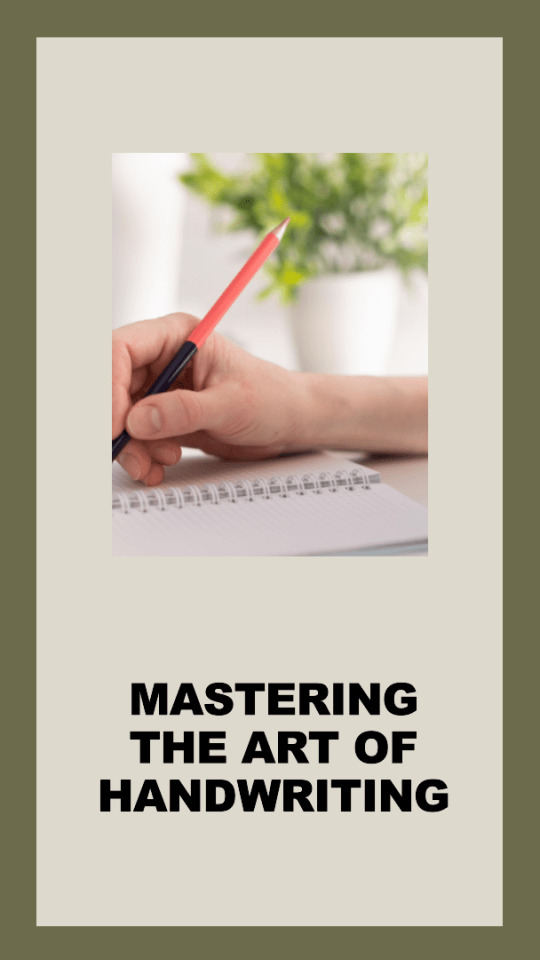
Writing by hand is more than a practical need; it's also a source of creative expression and an honorable ability. Improving your handwriting may lead to exciting new opportunities, whether you're a student hoping to improve the readability of your notes, a professional hoping to make a good impression with your script, or a creative spirit curious about the art of calligraphy. This in-depth manual will give you the tools and knowledge to perfect your handwriting. Let's get started on this thrilling adventure of discovery and originality!
The Basics of Better Handwriting
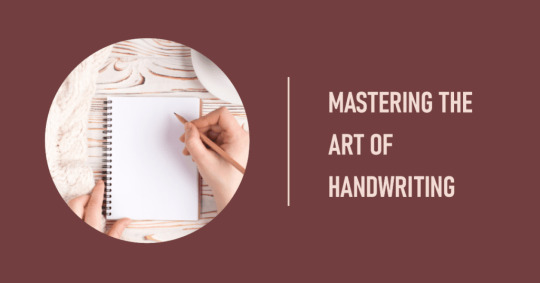
Mastering Handwriting The Value of Legible Handwriting The ability to communicate clearly and concisely via legible handwriting is essential. Clear, readable handwriting is essential to getting your point across when taking notes, writing letters, or filling out forms. Moreover, it shows who you are and may make an impression that lasts a long time. Good handwriting improves readability, efficiency, and even credibility in the business sector. The Importance of Handwriting at Work and Home In our private and professional lives, writing legibly is crucial. As individuals, it's how we represent ourselves in the world. How we shape letters and words may tell others a lot about ourselves. Good handwriting improves readability, efficiency, and even credibility in the business sector. It can improve our public profile and influence how others see our work. Basics of Good and Bad Handwriting: What Characterizes Each? One must first know what defines excellent and terrible handwriting to improve one's handwriting. In contrast to illegible, inconsistent, and time-consuming handwriting, good handwriting is readable, consistent, and efficient. But what factors determine excellent or terrible handwriting? It's more than simply about aesthetics. It's all about making the most of limited resources. What Makes a Handwritten Document Legible and Appealing Consistent letter construction, proper space between letters and words, uniform size and slant, and a fluid, effortless motion are all hallmarks of excellent handwriting. Your handwriting will benefit from these additions in terms of readability and aesthetics. However, your handwriting might be unsightly and difficult to read if the letters are all different sizes and forms and the lines between them are uneven.
The Quickest and Best Way to Boost Your Handwriting
It doesn't have to be challenging to practice better handwriting. Improving your handwriting is possible with the appropriate strategy and regular practice.

Handwriting Equipped for Success from the Get-Go The quality of your handwriting will improve dramatically if you invest in the proper instruments. Writing is more pleasant with a pen that doesn't hurt your hand and paper that glides easily over the page. Using the Appropriate Writing Instruments Your handwriting might seem quite different depending on the pen and paper you use. Writing might be more enjoyable with a pen that fits your hand well and flows ink easily. Similarly, writing more fluidly is possible on smoother paper. Try a few different writing implements and surfaces before settling on a routine that works best for you. Recognizing Different Writing Habits Each person has a unique handwriting style. Learning about the many types of handwriting will help you settle on a natural method. Print vs. Cursive: Which Is Better? Cursive writing, with its flowing and interwoven letters, may be speedier and more efficient than print writing, which is plain and easy to read. It's usually a matter of taste and function when deciding between print and cursive. If you're starting on the road to better handwriting, you may do well to focus on print first. How Your Posture Affects Your Handwriting Comfortable and practical handwriting requires good posture. It eases physical stress and gives you more command over your hand motions while writing. How to Get in the Best Writing Position Improving your handwriting may be as simple as sitting up straight, keeping your feet level on the floor, and centering your work. Holding your pen properly and without clutching it too hard is also crucial. A looser grip facilitates more straightforward motion and lessens hand strain. How to Grip a Pen

How Your Posture Affects Your Handwriting The way you hold the pen has a significant effect on your handwriting. Smoother, more controlled writing is possible with the correct grip and finger placement. How You Hold Your Pen Affects Your Writing For maximum command and comfort, the standard tripod grip is often advocated. Some individuals, however, may find greater ease in using the quadruped or a modified tripod. The trick is establishing a hand position that makes writing easy and natural.
The Secrets to Better, Neater Handwriting
Focusing on uniformity, spacing, and alignment may improve your handwriting's appearance. If you want neater handwriting, try these tactics. The Value of Maintaining a Uniform Handwriting Style A key component of readable handwriting is maintaining uniformity in letter size, orientation, and spacing. It makes your writing more aesthetically pleasing and more readable. Standardizing Fonts and Line Spacing Letter size and spacing may be more uniformly practiced on lined paper. Maintain regular space between letters and words and strive for consistency in the height of lowercase and uppercase characters. Graph paper is another helpful tool for perfecting your spacing and alignment skills. Slowing Down Is Powerful Poor handwriting is a typical result of being in a hurry. When you write more slowly, you may give more attention to the individual letters and ensure they are consistently spaced. The Impact of Speed on the Legibility of Your Handwriting If you try to write slowly, you'll have misshapen letters, lousy spacing, and sloppy handwriting. Writing more slowly may help with readability and neatness. You'll be able to type faster without sacrificing quality as you gain experience with your letter formations. Practice Makes Perfect Handwriting is a talent like any other, where practice makes perfect. A consistent, deliberate effort may bring about substantial growth. Practice Your Handwriting Exercises to Improve Your Handwriting Practice drawing loops, lines, and circles to strengthen your hands and increase your handwriting speed and fluidity. Letter formation practice and composing pangrams (sentences using every letter of the alphabet) are also helpful. Worksheets and exercises to help you improve your handwriting are available at no cost on the Internet.
15-Day Plan for Better Handwriting
The objective of drastically improving your handwriting in only 15 days is ambitious but possible. This time, you may progress significantly with the right mindset and plenty of practice.

15-Day Plan For Better Handwriting To Improve Your Handwriting, Step by Step A well-thought-out strategy will help you focus your efforts and achieve your goals. It would be best to begin by taking stock of your existing handwriting, establishing concrete targets for growth, and scheduling regular, dedicated practice sessions. Handwriting Practice Routines and Objectives Setting daily objectives will help you focus your training and see accurate results. The formation of letters might be worked on one day, spacing the next, and so on. Writing tasks, such as handwriting drills, letter practice, and paragraph writing, may be included daily. Always take stock of where you are concerning your objectives and make adjustments as necessary. Monitoring Your Development Keeping a journal of your handwriting progress may be an inspiring and helpful exercise. It's an excellent tool for tracking your development and pinpointing problem areas. . Maintaining a Journal with Pen and Paper Keep track of your development with a handwriting notebook. On day one, write a paragraph and continue to write the same paragraph every few days. You may see how far you've come, and be encouraged to keep practicing by comparing your earlier submissions. Maintaining Your Drive Improving one's handwriting takes time and effort. It takes work to keep going when things appear to be moving at a snail's pace. However, remember that every effort put into practice is progress toward your objective. Taking Pleasure in Even the Tiniest of Successes Even the smallest of enhancements is always welcome. You can keep your motivation up by celebrating these mini-victories. It might be as easy as mastering a previously intractable letter or a noticeable increase in writing speed.
How to Write Better Curves
Flowing and interconnected letters make cursive handwriting elegant and practical. However, it might be challenging to get the hang of. If you want to write more legibly in cursive, consider these suggestions. Cursive Letter Forms and Their Meanings The four primary strokes used to create cursive letters are the upstroke, downstroke, overcurve, and undercurve. Practicing these strokes may improve your cursive writing's control and flow. Developing Fluency in Cursive Writing Cursive lettering may begin after the fundamental strokes have been learned. Since lowercase letters are often utilized first, you should focus on them first. Cursive Writing Worksheets and Exercises Practice worksheets may help you perfect your cursive writing by showing you where to draw the lines and what size letters to make. Learn the alphabet, and then go on to write words and whole phrases. Guide to Writing Cursive Clearly and Effortlessly You may improve the legibility and fluidity of your cursive with little practice and attention to detail. For instance, keeping your cursive writing at a uniform angle can help it seem more unified. If you want your cursive writing to flow smoothly, you should only raise your pen between words, not in the middle of a letter.
State-of-the-Art Methods for Enhanced Handwriting
After you've practiced the fundamentals and watched your handwriting develop, you may go on to more sophisticated lettering methods. Handwriting Styles: An Investigation There is a wide variety of handwriting, each with its distinct features. The more styles you're exposed to, the more ideas you'll have for creating a look that's uniquely you. American Cursive to Calligraphy: Discovering Your Style Each kind of handwriting has its distinct qualities, whether it be the grace of Spencerian script, the simplicity of D'Nealian, or the fluidity of American cursive. Another option is calligraphy, beautiful handwriting that has been used for centuries. Mindfulness' Importance in Writing Practicing mindfulness, or paying attention in the present moment without judgment, may help improve handwriting. Improve your consistency and command of the game by sharpening your attention on each stroke. Focusing on the Here and Now Improves Your Writing When you're in the moment, you're more conscious of your pen grip, hand motion as it moves over the page, and the individual strokes that make up each letter. Your handwriting may benefit from this newfound insight. Handwriting's Influence on the Creative Process Writing by hand takes more than simply mastery; it's also an artistic medium. If you want to be more creative, practice your handwriting. The Influence of Good Handwriting on Creativity Writing by hand requires more cognitive processing than typing. It has been shown to enhance fine motor abilities, memory, and understanding and to spark original thought.
Keeping and enhancing your handwriting
Improving your handwriting is an ongoing process, not a one-time assignment. Some suggestions for keeping and bettering your handwriting are provided below.

Keeping And Enhancing Your Handwriting Regular Practice Is Crucial Handwriting is just another ability that benefits from frequent use and practice. Keep practicing even after you've reached your desired level of handwriting competence. Maintenance of Handwriting Proficiency The best way to keep your handwriting abilities sharp is to practice them often, even for a few minutes daily. Practicing handwriting might include keeping a diary, sending letters, and engaging in handwriting exercises. Embracing Your Uniqueness as a Person The uniqueness of each person's handwriting is one of its most endearing qualities. Adopt a writing style that speaks to who you are; don't be afraid to flaunt your peculiarities. Recognizing the Individuality in Everyone's Handwriting Your unique handwriting reflects your personality. These individual touches set your handwriting apart from anybody else's, from how you curl your 'y's to the additional flourish on your 'g's. Continual Improvement in Handwriting Skills You can never stop improving your handwriting skills, learning new things, whether a script, a calligraphy technique, or a handwriting exercise, may keep your handwriting journey exciting and gratifying for the rest of your life. Always Strive to Improve Your Handwriting Learn the art of handwriting by taking classes, watching videos, or reading guides. Many materials are available to help you maintain and improve your handwriting.
The Struggle to Write Better: A Brief Synopsis
Improving your handwriting is an adventure in individuality exploration. You can improve your handwriting and have fun with the right resources and approach. A Review of the Handbook for Better Handwriting From the fundamentals of excellent handwriting to more sophisticated strategies for steady progress, we've covered it all in this book. Remember that learning the fundamentals, writing frequently, and being patient are the keys to developing your handwriting. Key Learnings and Future Actions Improving your handwriting is a journey, and even incremental progress is worthwhile. Maintain a spirit of inquiry and delight in the process of discovery that is handwriting. Benefits of Good Handwriting The ability to write legibly and creatively is more than simply a talent; it's a need for effective communication and a representation of who you are. Improving your handwriting is like buying a lifetime of use. How Improved Handwriting Can Enrich Your Life Improved handwriting can boost confidence, enhance communication skills, and open new creative avenues. Take a pen in your hand and go to work if you want better handwriting. Read the full article
#Calligraphy#CursiveWriting#HandwritingExercises#HandwritingImprovement#HandwritingPractice#HandwritingStyles#HandwritingTechniques#HandwritingTips#Penmanship#WritingTools
0 notes
Text
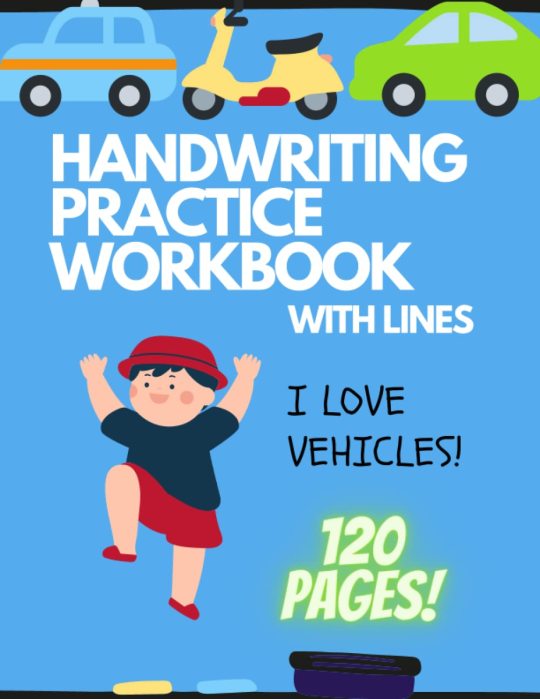
HANDWRITING PRACTICE WORKBOOK WITH LINES - I LOVE VEHICLES!: 120 WRITING PRACTICE PAGES - 8.5 X 11 INCHES - FOR KIDS, TEENS, STUDENTS, BOYS AND GIRLS Paperback – Jan. 23 2022
by TEACHUS Pressing (Author)
This lovely workbook includes:
Cool vehicles cover
120 pages of practice lines for handwriting and cursive writing, with cute cars and helicopters
For school work and as gifts
Thank you for your patronage! Need more beautiful covers? Check out and click the Author's page for more.
#handwritingpractice#handwritingworkbook#handwritingimprovement#handwritingtips#handwritingexercises#handwritinggoals#handwritingchallenge#handwritingclass#handwritinglessons#handwritingskills#handwritingfun#handwritingforkids#handwritingforadults#handwritingtherapy#handwritingpracticebook#handwritingpracticefun#handwritingpracticeideas#handwritingpracticegoals#handwritingpracticechallenge#handwritingpracticeclass#handwritingpracticetips#handwritingpracticeworkbook#handwritingpracticeteacher#handwritingpracticestudents#handwritingpracticetechniques#handwritingpracticemethods#handwritingpracticetechnology#handwritingpracticeresources#handwritingpracticeteaching#handwritingpracticestudy
0 notes
Text
HANDWRITING PRACTICE WORKBOOK WITH LINES - I LOVE VEHICLES!: 120 WRITING PRACTICE PAGES - 8.5 X 11 INCHES - FOR KIDS, TEENS, STUDENTS, BOYS AND GIRLS Paperback – Jan. 23 2022
by TEACHUS Pressing (Author)
This lovely workbook includes:
Cool vehicles cover
120 pages of practice lines for handwriting and cursive writing, with cute cars and helicopters
For school work and as gifts
Thank you for your patronage! Need more beautiful covers? Check out and click the Author's page for more.
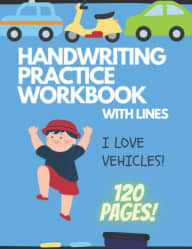
#handwritingpractice#handwritingworkbook#penmanship#cursive#handwritingimprovement#handwritingtips#handwritinggoals#handwritingchallenge#handwritingexercises#handwritingclass#handwritinglessons#handwritingforbeginners#handwritingforkids#handwritingforadults#handwritingtherapy#handwritingcoach#handwritingresources#handwritinghelp#handwritinginspiration#handwritinglove#handwritingfun#handwritingcommunity#handwritingisfun#handwritingmatters#handwritingpracticebook#handwritingworkbookforkids#handwritingworkbookforadults#handwritingworkbookforbeginners#handwritingworkbookforimprovement#handwritingworkbookforpractice
3 notes
·
View notes